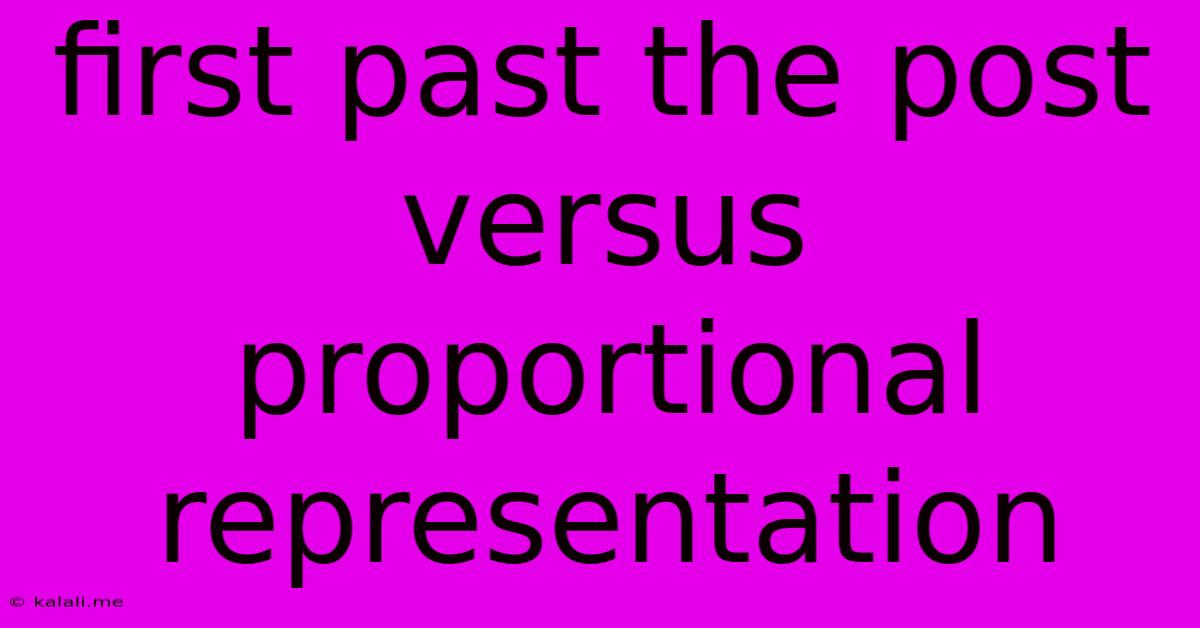First Past The Post Versus Proportional Representation
Kalali
Jun 11, 2025 · 3 min read

Table of Contents
First Past the Post vs. Proportional Representation: A Head-to-Head Comparison
Choosing the best electoral system is a crucial decision for any democracy. Two prominent systems stand out: First Past the Post (FPTP), also known as "winner-takes-all," and Proportional Representation (PR). This article delves into the strengths and weaknesses of each, exploring their impact on political representation and government stability. Understanding these differences is key to evaluating the effectiveness and fairness of a nation's democratic process.
First Past the Post (FPTP): A Simple System with Complex Consequences
FPTP is characterized by its simplicity. Voters choose a single candidate in their constituency, and the candidate with the most votes wins. This straightforward approach contributes to strong, single-party governments, fostering stability and efficient decision-making. However, this simplicity comes at a cost.
Advantages of FPTP:
- Strong Governments: FPTP often leads to single-party majority governments, capable of enacting their legislative agenda without significant opposition. This promotes political stability and effective governance.
- Clear Mandate: The winning candidate enjoys a clear mandate from their constituency, directly representing their local interests.
- Strong Local Links: The constituency system fosters strong links between elected representatives and their constituents, encouraging accountability and responsiveness.
- Simplicity and Ease of Understanding: The system is easy to understand and implement, requiring minimal resources and training.
Disadvantages of FPTP:
- Wasted Votes: Significant numbers of votes cast for losing candidates are effectively wasted, leading to a distorted representation of the overall electorate's preferences. This is particularly problematic for smaller parties.
- Disproportionate Results: A party can win a significant share of seats with less than 50% of the national vote, undermining the principle of proportional representation.
- Underrepresentation of Minority Parties: Smaller parties struggle to gain representation, even if they garner substantial support nationally. This can lead to marginalization of certain viewpoints and interests.
- Encourages Tactical Voting: Voters may strategically vote for a candidate other than their preferred choice to prevent a less desirable outcome, distorting the expression of genuine preferences.
Proportional Representation (PR): Fairer Representation, but with Trade-offs
Proportional representation aims to allocate seats in proportion to the votes received by each party. There are several variations of PR, including party-list systems, mixed-member proportional systems, and single transferable vote systems. These systems aim for greater fairness and inclusivity.
Advantages of PR:
- Fairer Representation: PR systems generally provide a more accurate reflection of the electorate's preferences, giving smaller parties a better chance of representation.
- Increased Voter Turnout: The perception of fairer representation can lead to higher voter turnout.
- Coalition Governments: PR often results in coalition governments, necessitating compromise and broader representation of diverse interests.
- Reduced Wasted Votes: Fewer votes are wasted compared to FPTP, leading to a more representative outcome.
Disadvantages of PR:
- Coalition Instability: Coalition governments can be unstable, prone to internal disagreements and shorter lifespans.
- Complexity: PR systems can be more complex to understand and implement than FPTP.
- Power to Smaller Parties: Smaller parties can wield disproportionate influence in coalition negotiations, potentially leading to policy gridlock.
- Weakened Local Links: The focus on national party lists can weaken the link between representatives and their local constituencies.
Conclusion: No Perfect System
Both FPTP and PR systems possess distinct advantages and disadvantages. FPTP offers simplicity and strong government, but at the cost of disproportionate results and wasted votes. PR promotes fairer representation and inclusivity, but can lead to coalition instability and complexity. The choice between these systems ultimately depends on a nation's priorities: prioritizing stability and efficiency versus prioritizing fairness and inclusivity. The "best" system is a matter of ongoing debate and depends heavily on the specific political and social context of a country.
Latest Posts
Latest Posts
-
Which Of The Following Is An Input Device
Jun 12, 2025
-
What Is The Square Root Of 784
Jun 12, 2025
-
The Number Of Neutrons In An Atom Is Equal To
Jun 12, 2025
-
Which Of The Following Electromagnetic Waves
Jun 12, 2025
-
Behaviorist Theory On Language Learning And Acquisition
Jun 12, 2025
Related Post
Thank you for visiting our website which covers about First Past The Post Versus Proportional Representation . We hope the information provided has been useful to you. Feel free to contact us if you have any questions or need further assistance. See you next time and don't miss to bookmark.